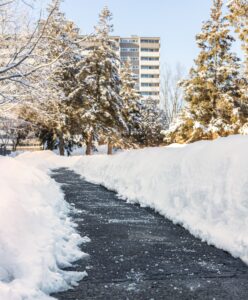Residential landlords are responsible for preventing “slip and fall” accidents on their properties, especially in the winter when surfaces can turn from icy one moment to slick the next. Failing to take the necessary precautions in terms of snow removal, floorcare, and proactive, preventative maintenance, can lead to costly litigation while marring the reputation of a building and its management.
According to the National Flooring Safety Institute, some eight million people visit hospital emergency rooms each year after a fall, with 12 per cent of those incidents resulting from a slippery surface. When a fall occurs in an apartment lobby, parking lot, walkway, or high-traffic communal area, the injured party may opt to pursue a claim against the owner or manager if negligence can be proven.
“Landlords are easy targets for slip and fall claims because they carry good insurance policies and are not always on the property to investigate the site in a timely way when it happens,” said Joe Hoffer, Partner, Cohen Highly LLP Lawyers. “If the landlord has adequate documentation of inspections, snow removal protocols, and video monitoring, these things can go a long way to mitigating questionable claims by opportunistic people.”
Whether it’s a single-family home, a townhouse complex, or a multi-residential apartment building, the property owner is ultimately responsible to ensure all communal areas are hazard-free. That said, occupiers (i.e., the tenants) also have an obligation to keep their entries clear. Those unable to address a potential risk from, say, a heavy snowfall or a spillage, should promptly notify the owner or manager who will be held responsible if an incident were to ensue.
Hoffer’s advice? “Stay vigilant and document everything because the onus will be on you.”

Outdoor best practices
In the past, many building managers have relied on de-icing salts such as rock salt or sodium chloride to lower their risk of outdoor accidents, but recent studies have exposed this method for its negative environmental impacts.
Effective as de-icing chemicals are, their extensive use can lead to the salinization of freshwaters, which degrades habitats for aquatic organisms and impacts drinking water for humans. Commercial property owners today are encouraged to seek out sustainable alternatives while also prioritizing safety.
To help achieve this goal—and to get ahead of government regulations that are expected to come in the near future—a new set of best practices were developed in response to a two-year Harvard study that looked at the drivers and variables influencing road salt application. Known as “SWiM” the strategy helps building operators better manage snow and ice, save money, and reduce their environmental impacts. The SWiM audit guidelines include more than 100 criteria that must be met to earn a SWiM certification, but facilities can also access the standards for their own informational purposes.
Anti-slip coatings
While frequent inspections and proactive maintenance will help minimize the risk of a tenant slipping on slick, weather-exposed surfaces, there are anti-slip coatings available to improve safety in high-traffic, high-risk areas.
According to one New York-based contractor, Roger Williams, the best anti-slip coatings are “safe and durable” while also delivering on their promise to minimize the potential for slip and fall accidents. Having recently explored several options for a project at a residential complex, Williams discovered that not all coatings were created equal, and that while some solutions can only be applied to a specific substrate, others may be applied to a wider range of surfaces.
“One product, which was very expensive, claimed it made wet surfaces ‘non-slip,’ but it did not work well on the steps that were known to get slick when wet,” he said.
Furthermore, to use the product, it meant several coats of concrete sealer needed to be stripped prior to application—a costly, messy, and time-consuming ordeal. Instead, Williams opted for a “true epoxy binder” with embedded aggregate that not only improved the traction of the steps, but also maintained the aesthetics of the Chattahoochee stone.
In conclusion, Williams advises those in the market for an anti-slip coating to do their research and choose one that will “resist shrinking, retain aggregate to improve traction and endure many years of wear.”
For more on this coating, visit: form-a-tread.com





